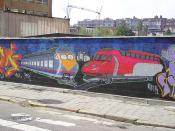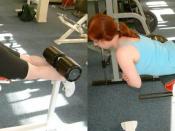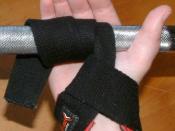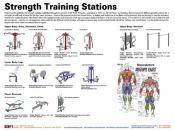There have been many controversies in whether resistance training is safe and effective for pre-adolescents. Pre-adolescent is defined as girls twelve and under and boys thirteen and under.( Falk & Tenenbaum, 1996) Is it possible to obtain strength gains through resistance training programs? This essay will investigate the benefits and consequences that occur through resistance training in children. At the end you should be able to clearly choose a side, based on the research.
Traditionally resistance training was considered ineffective and potentially harmful; However, coaches found that if their young athletes used control and progressed gradually their performance increased. This is best exemplified by gymnasts because they repeatedly generate high levels of power outputs and impose heavy loads to their muscles, bones, and connective tissue in the process of learning new skills. (Blimkie & Marion, 1993) There have been many arguments that include strength gains can not be made before puberty, and will harm their growth plates, and may cause other injury.
These studies conducted in the 60's and 70's believe this because people associate gains with hypertrophy and children show limited capacity to this. (Blimkie & Marion, 1993) They also believed high training loads would be harmful to normal development of the cardiorespitory system because it could thicken the left ventricle wall therefore decrease cardiovascular capacity. Young athletes with hypertension may experience further elevation of blood pressure from isometric demands of strength training. ( Pediatrics, 2001) Risks for injury and growth related problems result from undue stress imposed in the musculoskeletal system, especially in the sensitivity of joint structures and growth plates of long bones. However, more recent studies have found that strength gains are possible. They found that if you incorporate moderate to high training loads, and if you controlled for effects of growth and motor skill acquisition these gains can be made.
They also found that children are equally if not more trainable in relative strength than adolescents and adults; However when you associate absolute strength they are by far less trainable. (Blimkie & Marion, 1993) There were twenty-five studies with a maximum age for girls of twelve and boys thirteen which showed an increase of strength. Nine were sufficiently detailed and controlled to access common magnitudes of effect. The size of effect modified by variables (load, frequency, and intensity). Three studies showed no effect, but the other six studies showed improvements between thirteen and thirty percent of relative strength. The studies that do not show increases are often not published so there is a chance of bias to the public. They found no differences in gender, and the highest gains are at the beginning due to adaptation. (Falk & Tenenbaum, 1996) The program guidelines for preadolescents are pretty much the same throughout the board. There frequency should be two to three times a week, the duration should not exceed thirty minutes, should complete eight to fifteen repetitions and one to three sets. They also have to progress very minimally, about one to one and a half kilograms once they are able to complete fifteen repetitions with good technical execution.( Blimkie & Marion, 1993) When they perform exercises they should use slow, smooth, methodical movements to reduce shear, tensile, and compression forces and to decrease the risk of epiphyseal and other injuries. When creating a program the trainer should avoid overhead lifts because they are the most dangerous.
(Lombardi, 1989) Pre-adolescents should also use all muscle groups and full range of motion should be executed. (Pediatrics, 2001) There are some concerns whether or not it is safe to start resistance training at an early age. It is found that resistance training is not risky in terms of musculoskeletal injury when the participants are closely supervised, properly instructed, and their programs are appropriately prescribed. (Lombardi, 1989) Controlled resistance training may even offer protection by strengthening muscles that cross a joint.(Blimkie & Marion, 1993) When preformed properly and safe, it can lower a child's risk of sustaining sports related injury due to muscle tissue that protects the musculoskeletal system. (Bryant & Peterson, 1997) People often associate growth injuries from weight lifting, but there are many other sports that cause undue stress to the musculoskeletal system, such as baseball, basketball, swimming, and tennis, from excessive loads.( Blimkie & Marion, 1993) Guardians are encouraged to consult a physician before starting a program to evaluate their physical, and mental ability, interest level, prior experiences, and goals. (Roberts, 2002) Resistance training can improve strength per cross-sectional muscle area, which is relative strength, as I mentioned before. There is a increase in muscle size through neuro-adaptaions in the early stages of the program. There is improved movement coordination factor contributing strength gains through multi-joint exercises. (Pediatrics, 2001) Also it is found that training induced strength gains are impermanent and they can't maintain by only training once a week. This could be because of the lack of hypertrophy and motor unit activation resulting from reduced training stimulus. (Blimkie& Marion, 1993) Through neuromuscular "learning" training increases the number of motor neurons that will fire with each muscle contraction.(Pediatrics, 2001) In relation to cardiovascular fitness resistance training has little effect on relative and absolute VO2 max.There are findings that training for less than twenty weeks has no negative effect on normal development of cardiovascular fitness.
On the contray resistance programs using hydraulic or isokinetic and featuring alternative concentric contractions between agonistic and antagonistic muscles may provide improvements in both strength and VO2 max.(Blimkie & Marion, 1993) This is because it may provide a positive stimulus under specific conditionsFor the younger group ages eight plus, resistance training increases neuro motor skills, strength, bone development by increasing bone density, strength of bone connective tissue, muscle energy capacity, and it strengthens the heart muscle.
Studies also show that resistance training in non athletic children can increase their strength by up to 30%, and athletic children show sport proficiencies at earlier ages. (Benifits of a Resistance Training Program, 2000) In conclusion I have found that is safe for children to train as long as they have proper supervision, use proper techniques, and follow a prescribed program. In the nine studies that used control, there were only two documented injuries, but they were only out for two to three days.(Faulk & Tenenbaum, 1996) After looking at the research despite what some think, I believe that training is also effective for pre-adolescents. I think you will agree with me because the benefits are larger than the consequences as you saw. Children improve their relative strength more than adults and adolescents in the begining because of adaptation. I do not think that there is an exact age where children can start lifting heavy weights, it all depends on the individuals, mental and physical ability. All the documentation that I have read states they can start lifting heavy weights when they have reached puberty, and maturation. Girls reach puberty faster, around age twelve, and boys later, around age thirteen, so after they have reached this age depending on mental and physical ability they should be able to lift heavy weights.





